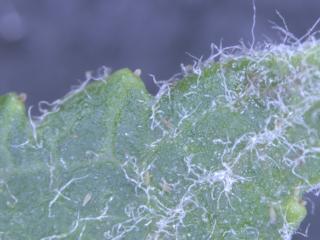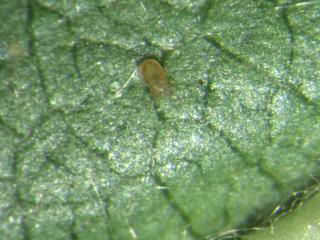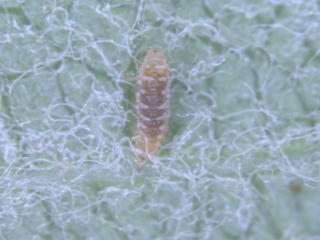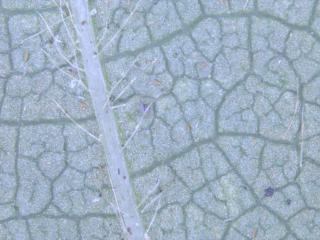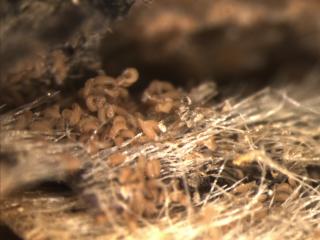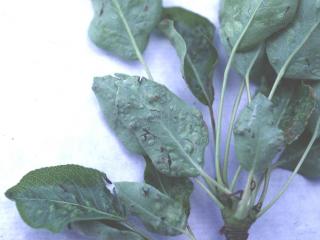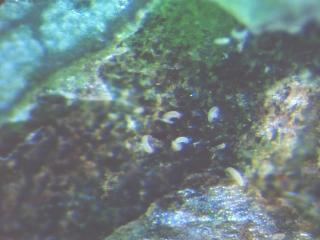Apple rust mite
Apple rust mite (Aculus schlechtendali) is an occasional pest of apples. Mites feed on leaves causing them to turn grey, reducing their photosynthetic potential and heavy populations may result of scarring of the skin of apples. Nymphs are pale and adults are light brown and torpedo shaped. This mite is in the eriophyid group, with adults being very small at approx. 0.2mm long. Leaves require microscopic examination to confirm whether apple rust mite is the cause of leaf discolouration. Such discolouration is the best indicator of the presence of this pest mite. Usually the mites are controlled by a predatory mite and spraying is not required. These predatory mites have been identified to belong to the Amblyseius bellinus group. This species of predatory mite has not been recorded as a predator of either two-spotted mite or European red mite in WA apple orchards. Other predators such as larvae of a species of fly also help reduce the abundance of apple rust mite.
Plum rust mite
Plum rust mite (Aculus fockeui), previously known as peach silver mite, is an occasional pest of peach and nectarine trees. The mites are so small (about one-sixth of a millimetre long), that the first sign that they are present is when leaves turn grey as a result of their feeding. A microscope is needed to confirm their presence.
Whether control measures are required depends on the level of leaf infestation, which is indicated by leaves turning grey or appear as if covered in dust. If a high proportion of trees are infested and most of the foliage on each tree is turning grey, a miticide is required. Unlike other species of pest mites, plum rust mite does not seem to be a pest each season. This lack of consistent pest occurrence suggests predators are unlikely to help control them. Also, this may explain why predatory mites have not yet been detected when infestations of plum rust mite occur.
Miticides containing the active ingredient milbemectin control plum rust mite. Other registered miticides containing etoxazole and fenbutatin oxide have been tested and found effective against this eriophyid group of mites, but they were not specifically examined for their effectiveness against plum rust mite..
Plum leaf mite
Plum leaf mite (Phyllocoptes abaenus) has been recorded on one occasion only, damaging the growing tips on plums trees in WA. The margins of emerging new leaves were bronzed and the growing tip was smaller and slightly distorted compared with uninfested growing tips. The mites are small - similar to plum rust mite.
The occurrence of this mite is so sporadic that it is regarded as a minor pest.
Pearleaf blister mite
Pearleaf blister mite (Eriophyes pyri) is an occasional pest of pear trees. The mites are so small (about one-fifth of a millimetre long), that the first sign they are present is when leaves develop characteristic yellow/green blisters on the upper leaf surface. These blisters turn brown and black as the affected leaf tissue dies. In heavy infestations, fruit may be infested and become scarred or misshapen. The blisters on leaves appear because the mites feed within a cavity in the leaf. The cavity has a hole on the lower leaf surface through which adults can move to set up other colonies. A microscope is needed to confirm that they are the cause. Adult mites are pale and torpedo shaped with two pairs of legs at the head end. They have multiple generations through the growing season before entering buds in which they overwinter.
Unlike other species of pest mites, the occurrence of pearleaf blister mite is very sporadic. Consequently, predators are unlikely to help control them. The predatory mite Metaseiulus occidentalis which occurs in WA orchards, reportedly feeds on pearleaf bister mite. Infestations may build within and between seasons. If a high proportion of trees show signs of infestation, further damage may be prevented with the application of miticide, as listed in the table below or as suggested above for plum rust mite control.
Further reading
Bower CC & Thwaite WG 1995, The mite management manual — a practical guide to integrated mite control in apples. NSW Industry and Investment (DPI).
Hetherington S 2005, Integrated pest and disease management for Australian summerfruit. NSW Industry and Investment (DPI) and Summerfruit Australia.
Hetherington S 2009, Integrated pest management for Australian apples and pears. NSW Industry and Investment (DPI) and Apple and Pear Australia Limited.
Malipatil MB, Williams DG & Semeraro L 2009, Pests of pome and stone fruit and their predators and parasitoids — a pocket guide. Department of Primary Industries, Victoria.

